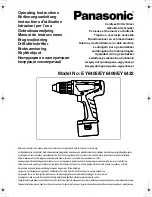
—
7
—
III. OPERATION
Switch and Forward / Reverse
lever Operation
(Forward (
), Switch lock, Reverse (
))
CAUTION:
Do not operate Forward/Reverse
lever until the chuck comes to a com-
plete stop. Shifting during rotation of
the chuck may damage the tool.
Forward Rotation Switch Operation
1. For forward rotation, set the lever to forward.
2. Depress the trigger switch slightly to start the
tool slowly.
3. The speed increases with the amount of
depression of the trigger for efficient tightening
of screws and drilling. The brake operates and
the chuck stops immediately when the trigger
is released.
4. After use, set the lever to its center position
(switch lock).
Reverse Rotation Switch Operation
1. For reverse rotation, set the lever to reverse.
Check the direction of rotation before use.
2. Depress the trigger switch slightly to start the
tool slowly.
3. After use, set the lever to its center position
(switch lock).
Speed Selection
Choose a low or high speed to suit the use.
CAUTION:
Check the speed selector switch
before use.
Clutch Torque Setting
Adjust the torque to one of the 18 possible set-
tings or “
” position to the job.
CAUTION:
Test the setting before actual opera-
tion. Set the scale at this mark (
).
(Fig. 7)
Note:
When the brake operates, a braking sound
may be heard.
This sound indicates engagement of the bit
lock.
CAUTION: •
To eliminate excessive tempera-
ture increase of the tool surface,
do not operate the tool continu-
ously using two or more battery
packs.
Tool needs cool off time before
switching to another pack.
•
Do not close up vent holes on
body sides of the body during
operation.
Otherwise, the machine function is
adversely affected to cause a fail-
ure
•
Do NOT strain the tool(motor).
This may cause damage to the
unit.
•
Use the machine in such a way as
to prevent the air from the body
vent holes from blowing directly
onto your skin. Otherwise, you
may get burnt.
•
When operating with a Ni-MH bat-
tery pack, make sure the place is
well-ventilated.
For Appropriate use of Battery pack
Ni-MH Battery pack (EY9200/EY9201/
EY9230/EY9231)
• Charge the Ni-MH battery fully before storage
in order to ensure a longer service life.
• The ambient temperature range is between
0°C (32°F) and 40°C (104°F).If the battery
pack is used when the battery temperature is
below 0°C (32°F), the tool may fail to function
properly. In that case, charge the bat¦tery until
charging is completed for appropriate function-
ing of the battery.
• When battery pack is not in use, keep it away
from other metal objects like: paper clips,
coins, keys, nails, screws, or other small metal
objects that can make a connection from one
terminal to another.
Shorting the battery terminals together may
cause sparks, burns or a fire.
• When operating with a Ni-MH battery pack,
make sure the place is well-ventilated.
Ni-Cd Battery pack
(EY9106/EY9136)
• Nickel cadmium battery pack requires a
“BREAK-IN PERIOD” to reach maximum oper-
ating capacity. The “BREAK-IN PERIOD” is
accomplished during normal usage during the
first 6-8 charge and discharge cycles of the
battery pack.
After the “BREAK-IN PERIOD” is completed,
the battery pack will maintain maximum operat-
ing capacity throughout the normal life of the
battery pack.
Battery Pack Life
The rechargeable batteries have a limited life. If the
operation time becomes extremely short after
recharging, replace the battery pack with a new one.
Note:
Use under extremely hot or cold conditions
will reduce operating capacity per charge.
EY6405(EU).book Page 7 Wednesday, June 15, 2005 7:14 PM
Summary of Contents for EY6405 - CORDLES DRILL&DRIVER
Page 11: ... 11 MEMO ...
Page 53: ... 53 ...








































